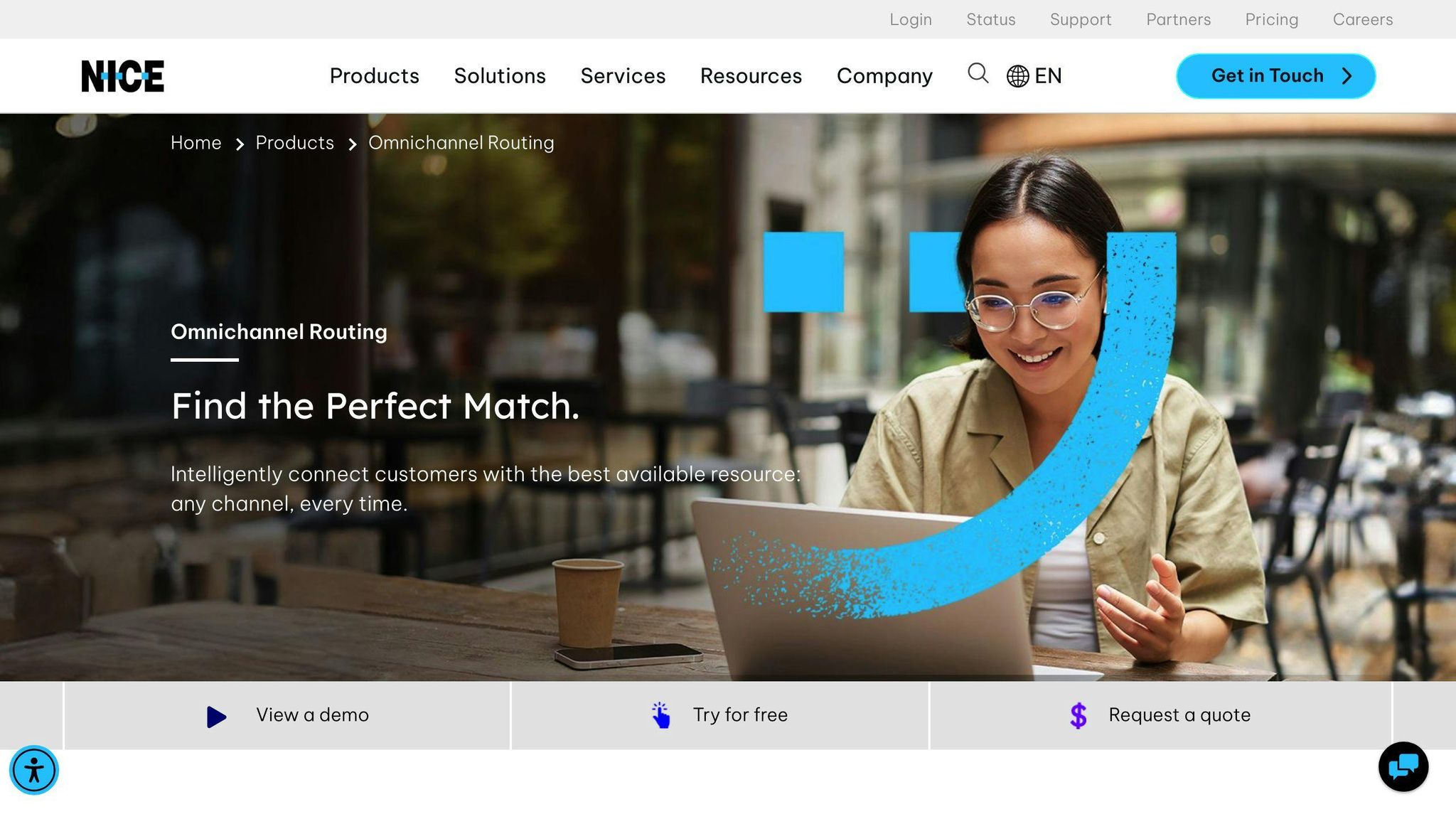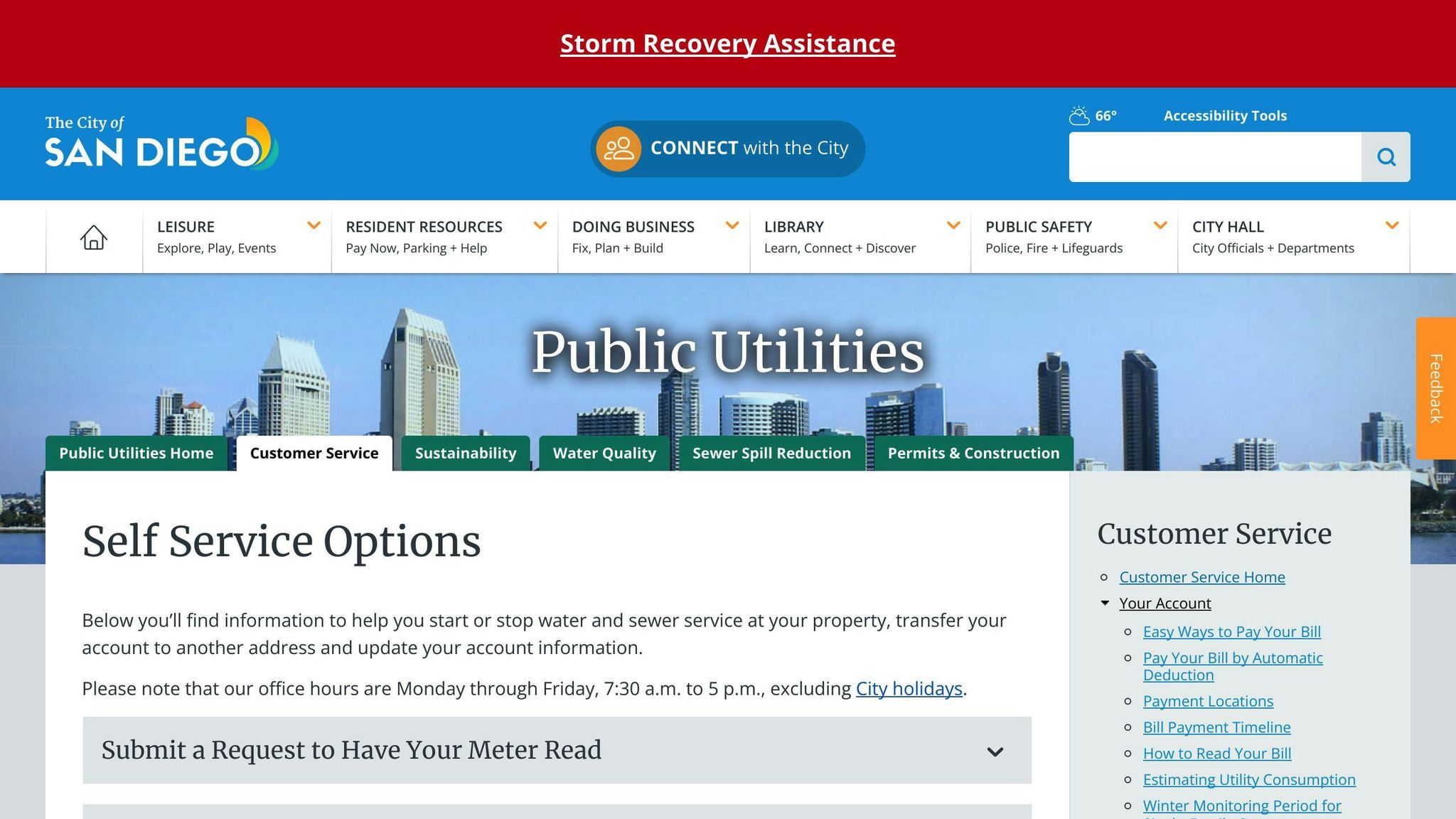
Top 9 AI Routing Features for Customer Service 2024
Cut response times by 65% and boost customer satisfaction with smart routing that connects customers to the right agent instantly.

Written by
Adam Stewart
Key Points
- Route calls using sentiment analysis to match frustrated customers with senior agents
- Reduce wait times 40% with predictive routing based on customer history
- Save 3+ hours daily with real-time agent coaching and automated task handling
- Track resolution rates across channels to identify your best-performing routing rules
Excellent customer service is key to business success. AI routing solutions can greatly improve customer experiences, boost agent productivity, and drive growth. By adopting these top 9 AI routing features, businesses can meet evolving customer needs:
- Intelligent Call Routing: Analyzes caller details and inquiry type to route calls to the best agent for faster resolution and shorter handle times.
- Natural Language Processing (NLP): Understands customer language to identify needs and emotions, enabling accurate sentiment analysis, personalized responses, and efficient problem-solving.
- Sentiment Analysis: Detects customer emotions and sentiment to prioritize and route calls accordingly, leading to proactive issue resolution and increased satisfaction.
- Predictive Analytics: Analyzes customer data to predict needs and preferences, enabling personalized experiences, proactive support, and improved loyalty.
- Omnichannel Routing: Routes customers to the most suitable agent or channel based on preferences and needs, ensuring seamless experiences, reduced wait times, and better agent efficiency.
- Self-Service Options: Provides self-service tools for customers to resolve issues independently, reducing call volumes, increasing customer autonomy, and cutting costs.
- Agent Assistance: Offers real-time guidance and suggestions to agents for better responses and resolutions, leading to faster issue resolution and happier customers.
- Workforce Management: Optimizes agent schedules, skills, and availability for efficient call handling, improving productivity, reducing wait times, and increasing satisfaction.
- Continuous Improvement: Analyzes customer data and feedback to refine the AI routing process, increasing customer satisfaction, loyalty, and reducing churn.
Related video from YouTube
Quick Comparison
| Feature | What It Does | Benefits |
|---|---|---|
| Intelligent Call Routing | Routes calls based on caller details and inquiry type | Faster resolution, shorter handle times |
| Natural Language Processing (NLP) | Understands customer language and needs | Personalized responses, efficient problem-solving |
| Sentiment Analysis | Detects customer emotions and sentiment | Proactive issue resolution, increased satisfaction |
| Predictive Analytics | Predicts customer needs and preferences | Personalized experiences, proactive support |
| Omnichannel Routing | Routes customers across channels based on preferences | Seamless experiences, reduced wait times |
| Self-Service Options | Provides self-service tools for customers | Fewer call volumes, increased autonomy |
| Agent Assistance | Offers real-time guidance to agents | Faster resolution, happier customers |
| Workforce Management | Optimizes agent schedules and skills | Improved productivity, reduced wait times |
| Continuous Improvement | Refines AI routing process based on data | Increased satisfaction, loyalty, reduced churn |
AI routing offers faster issue resolution, shorter handle times, increased customer satisfaction, and improved loyalty. By automating routine tasks, AI frees up agents to focus on complex issues requiring human empathy and understanding. AI-driven insights also help businesses refine their customer service strategies and make data-driven decisions.
1. Intelligent Call Routing

Intelligent call routing directs customer calls to the right agent or department. It uses data to understand the caller's needs and preferences.
Customer Data Analysis
The system analyzes:
- Caller ID
- Location
- Time of day
- Past interactions with the company
This data helps identify the caller's intent and route them to the best resource.
Real-time Guidance
Intelligent call routing provides agents with:
- Relevant customer information
- Suggestions to personalize the experience
This guidance helps agents resolve inquiries efficiently.
| Intelligent Call Routing | Description |
|---|---|
| Customer Data Analysis | Analyzes caller ID, location, time, and past interactions to understand the caller's intent. |
| Real-time Guidance | Provides agents with customer data and suggestions for personalized service. |
2. Natural Language Processing (NLP)
NLP technology helps companies understand customer interactions better. It analyzes customer messages, emails, and calls to identify their intent, sentiment, and preferences.
Understanding Customer Needs
NLP examines customer interactions across channels like chat, email, and voice. It determines:
- What the customer wants (intent)
- How the customer feels (sentiment)
- The customer's preferences
This insight allows companies to provide personalized service.
Guiding Agents in Real-Time
NLP provides agents with:
- Relevant customer information
- Suggestions for personalized responses
This real-time guidance helps agents resolve issues efficiently.
Seamless Channel Integration
NLP works across various channels, including:
- Chatbots
- Voice assistants
This integration ensures a consistent experience for customers.
Key Benefits of NLP
| Benefit | Description |
|---|---|
| Improved Customer Satisfaction | Understanding customer sentiment and preferences leads to better service. |
| Faster Response Times | Real-time guidance helps agents respond quickly to inquiries. |
| Higher Agent Productivity | NLP automates routine tasks, freeing agents for complex issues. |
3. Sentiment Analysis

Sentiment analysis helps businesses understand how customers feel about their products or services. This feature analyzes customer interactions across chat, email, and voice channels to identify their emotions, intentions, and preferences.
Analyzing Customer Data
Sentiment analysis examines customer data to determine if their tone is positive, negative, or neutral. This analysis helps identify areas for improvement, such as product features or customer service, that may be causing dissatisfaction.
Guiding Agents in Real-Time
Sentiment analysis provides real-time guidance to agents, enabling them to respond promptly and empathetically to customer concerns. This guidance helps agents resolve issues efficiently, leading to higher customer satisfaction.
Consistent Experience Across Channels
Sentiment analysis works seamlessly across various channels, ensuring a consistent customer experience. By analyzing interactions across channels, businesses can identify patterns and trends, enabling data-driven decisions to improve their offerings.
| Sentiment Analysis | Description |
|---|---|
| Customer Data Analysis | Examines customer data to determine their emotional tone (positive, negative, or neutral). |
| Real-time Guidance | Provides agents with guidance to respond promptly and empathetically to customer concerns. |
| Channel Integration | Works across chat, email, and voice channels for a consistent customer experience. |
4. Predictive Analytics

Predictive analytics helps companies understand what customers might need before they ask. It looks at past customer data to find patterns and predict future events.
Analyzing Customer Data
Predictive analytics studies customer information like preferences, behaviors, and issues. This helps companies understand their customers better and create personalized experiences and marketing.
Proactive Support
By analyzing data, predictive analytics can spot potential problems before they happen. Companies can then take action to resolve issues early, preventing customer frustration.
| Predictive Analytics | Description |
|---|---|
| Customer Data Analysis | Studies customer preferences, behaviors, and issues to understand them better. |
| Proactive Support | Identifies potential problems early, allowing companies to resolve issues before customers experience frustration. |
5. Omnichannel Routing

Omnichannel routing allows customers to interact with a company through various channels like phone calls, text messages, emails, live chat, and social media. It integrates these channels into one interface for agents, ensuring a unified conversation history and preventing communication gaps.
Channel Integration
Customers can contact the company using their preferred channel, and agents can respond accordingly. This integration provides a smooth and efficient customer support experience. By utilizing omnichannel routing, companies can streamline their support operations, reduce wait times, and increase customer satisfaction.
Priority Support
Omnichannel routing enables businesses to offer priority support to high-value customers and VIPs. This is achieved through customer segmentation based on their value to the company. For example, in retail, loyal customers may receive priority assistance for refunds, returns, or live support, without waiting in queues. By providing speedy support, businesses can turn VIP customers into brand advocates who drive referrals and positive word-of-mouth.
| Omnichannel Routing | Description |
|---|---|
| Channel Integration | Integrates multiple communication channels into one agent interface, ensuring a unified conversation history. |
| Priority Support | Offers priority assistance to high-value customers and VIPs, promising faster resolutions and no wait times. |
sbb-itb-ef0082b
6. Self-Service Options

Self-service options allow customers to resolve issues independently, without needing assistance from a support agent. AI-powered self-service can significantly reduce the workload for customer service teams, enabling them to focus on more complex matters requiring human intervention.
Personalized Solutions
AI algorithms analyze customer data to provide personalized solutions tailored to their specific needs. By identifying patterns and trends in customer data, the system can offer targeted solutions, quickly resolving issues and enhancing the overall customer experience.
Step-by-Step Guidance
Self-service options provide real-time, step-by-step guidance to customers, helping them resolve issues efficiently. AI-powered chatbots and virtual assistants offer clear instructions, guiding customers through the resolution process. This timely support reduces frustration and dissatisfaction.
Seamless Integration
Self-service capabilities can be integrated across various communication channels, including phone, email, live chat, and social media. This allows customers to access self-service options through their preferred channel, ensuring a consistent and convenient experience across all touchpoints.
| Self-Service Options | Description |
|---|---|
| Personalized Solutions | AI analyzes customer data to provide tailored solutions, resolving issues quickly. |
| Step-by-Step Guidance | Chatbots and virtual assistants offer clear instructions, guiding customers through the resolution process. |
| Seamless Integration | Self-service options are available across multiple channels, ensuring a consistent experience. |
7. Agent Assistance

Agent assistance is a key AI routing feature that helps customer service agents provide better support. By using AI, agents can access useful information, real-time guidance, and tools to resolve issues quickly.
Understanding Customer Data
AI analyzes customer data to give agents a complete view of customer behavior, preferences, and issues. This helps agents offer personalized solutions, anticipate needs, and address potential problems early.
Step-by-Step Guidance
AI provides agents with step-by-step instructions to resolve complex issues. This real-time guidance reduces errors, increases first-call resolutions, and improves the overall customer experience.
Proactive Support
AI identifies potential issues before they escalate, allowing agents to reach out to customers and offer solutions proactively. This approach improves customer satisfaction and reduces incoming support requests.
| Agent Assistance | Description |
|---|---|
| Customer Data Analysis | AI gives agents a 360-degree view of customer data for personalized solutions and proactive support. |
| Real-time Guidance | AI offers step-by-step instructions to resolve complex issues, reducing errors and increasing first-call resolutions. |
| Proactive Support | AI identifies potential issues early, enabling agents to offer proactive solutions and prevent problems. |
8. Workforce Management

Effective workforce management helps contact centers have the right agents, with the right skills, at the right time. AI-powered workforce management tools can optimize labor costs, boost productivity, and increase employee retention.
Channel Integration
These tools integrate with various channels like phone, email, chat, and social media. This provides a unified view of customer interactions. It allows contact centers to manage their workforce better by assigning agents to the right channels and tasks.
Forecasting and Scheduling
AI-powered forecasting and scheduling analyze historical data, seasonal trends, and real-time traffic. This helps predict call volumes and schedule agents accordingly. The right number of agents are available to handle customer inquiries, reducing wait times and improving satisfaction.
Performance Management
AI-powered performance management provides real-time insights into agent performance. This helps identify areas for improvement and provide targeted coaching and training. As a result, agent productivity improves, errors reduce, and first-call resolutions increase.
| Workforce Management | Description |
|---|---|
| Channel Integration | Integrates with various channels for a unified view of customer interactions. Assigns agents to the right channels and tasks. |
| Forecasting and Scheduling | Predicts call volumes and schedules agents accordingly using historical data and trends. Ensures the right number of agents are available. |
| Performance Management | Provides real-time insights into agent performance. Enables targeted coaching and training to improve productivity and first-call resolutions. |
9. Continuous Improvement

Continuously improving the AI routing process is crucial for delivering excellent customer service. It involves analyzing customer data, identifying areas for enhancement, and implementing changes to optimize the routing system.
Analyzing Customer Data
Examining customer interactions, emotions, and behavior helps identify trends, preferences, and pain points. This information guides refinements to the routing process, ensuring customers are directed to the most suitable agents or channels.
Real-time Guidance for Agents
Providing agents with real-time insights and suggestions empowers them to make informed decisions and respond to inquiries more effectively. This can lead to:
- Improved first-call resolutions
- Reduced handle times
- Enhanced customer satisfaction
Proactive Support
Anticipating customer needs and proactively offering solutions can reduce incoming inquiries and improve satisfaction. AI-powered routing can:
- Identify potential issues
- Trigger proactive support measures, such as:
- Sending personalized notifications
- Offering self-service options
| Continuous Improvement | Description |
|---|---|
| Customer Data Analysis | Examine customer interactions, emotions, and behavior to identify trends, preferences, and pain points. |
| Real-time Guidance | Provide agents with real-time insights and suggestions for informed decision-making and effective responses. |
| Proactive Support | Anticipate customer needs, identify potential issues, and offer proactive solutions like personalized notifications or self-service options. |
Comparison Table
Here's a table comparing the key features and benefits of AI routing for customer service:
| Feature | What It Does | Benefits |
|---|---|---|
| Intelligent Call Routing | Analyzes caller details, past interactions, language preferences, and inquiry type to route calls to the best agent. | Faster issue resolution, shorter handle times, and happier customers. |
| Natural Language Processing (NLP) | Understands customer language to identify their needs and emotions. | Accurate sentiment analysis, personalized responses, and efficient problem-solving. |
| Sentiment Analysis | Detects customer emotions and sentiment to prioritize and route calls accordingly. | Proactive issue resolution, increased customer satisfaction, and reduced churn. |
| Predictive Analytics | Analyzes customer data to predict their needs and preferences. | Personalized experiences, proactive support, and improved customer loyalty. |
| Omnichannel Routing | Routes customers to the most suitable agent or channel (phone, email, chat, etc.) based on their preferences and needs. | Seamless customer experiences, reduced wait times, and better agent efficiency. |
| Self-Service Options | Provides customers with self-service tools to resolve issues independently. | Fewer call volumes, increased customer autonomy, and cost savings. |
| Agent Assistance | Offers real-time guidance and suggestions to agents for better responses and resolutions. | Faster issue resolution, shorter handle times, and happier customers. |
| Workforce Management | Optimizes agent schedules, skills, and availability for efficient call handling. | Improved agent productivity, reduced wait times, and increased customer satisfaction. |
| Continuous Improvement | Analyzes customer data and feedback to refine the AI routing process. | Increased customer satisfaction, improved loyalty, and reduced churn. |
This table provides a clear overview of the key features and benefits of AI routing in customer service, helping businesses make informed decisions when implementing AI-powered routing solutions.
Conclusion
In today's fast-moving digital world, excellent customer service is key to business success. Using AI routing features can greatly improve customer experiences, boost agent productivity, and drive growth. By adopting the top 9 AI routing features discussed here, businesses can stay ahead and meet evolving customer needs.
AI routing offers many benefits, including:
- Faster Issue Resolution: Customers get connected to the right agent quickly, reducing wait times and frustration.
- Shorter Handle Times: Agents handle inquiries they're best equipped for, optimizing their time.
- Increased Customer Satisfaction: Personalized, efficient service leads to happier customers.
By automating routine tasks, AI frees up agents to focus on complex issues requiring human empathy and understanding. AI-driven insights also help businesses refine their customer service strategies and make data-driven decisions.
As customer expectations rise, investing in AI routing solutions that deliver personalized, efficient experiences is crucial. This builds trust, loyalty, and long-term customer relationships, ultimately driving business success and growth.
Key Benefits of AI Routing
| Benefit | Description |
|---|---|
| Faster Resolution | Customers connect with the right agent quickly, reducing wait times. |
| Shorter Handle Times | Agents handle inquiries they're best equipped for, optimizing their time. |
| Increased Satisfaction | Personalized, efficient service leads to happier customers. |
| Agent Focus | AI automates routine tasks, freeing agents for complex issues. |
| Data-Driven Decisions | AI insights help refine customer service strategies. |
| Customer Loyalty | Personalized experiences build trust and long-term relationships. |
| Business Growth | Excellent customer service drives success and growth. |
FAQs
How can AI help with customer service?
AI can assist human customer service agents in several ways:
1. Task Automation
AI can handle routine tasks like:
- Case management
- Call routing
This allows human agents to focus on complex queries and relationship building.
2. Context Retrieval
AI can quickly retrieve customer information, giving agents a complete understanding of the customer's history and preferences.
3. Sentiment Analysis
AI can analyze customer sentiment and intent, enabling agents to respond more effectively.
4. Intelligent Routing
AI can route customers to the most suitable agents based on factors like:
- Language preferences
- Previous interactions
- Nature of the inquiry
This ensures customers are connected with agents best equipped to resolve their issues, leading to faster resolution times and increased satisfaction.
| AI Capability | Benefit |
|---|---|
| Task Automation | Frees up agents for complex queries |
| Context Retrieval | Provides agents with customer history and preferences |
| Sentiment Analysis | Helps agents respond effectively |
| Intelligent Routing | Connects customers with the right agents |
Summarize with AI
Related Posts
AI in Omnichannel Contact Centers: 5 Ways It Transforms CX
Discover how AI is transforming customer experiences in omnichannel contact centers through personalized interactions, efficient self-service, and continuous improvement.
Call Center Automation AI: Enhancing Customer Support
Discover how call center automation AI enhances customer support with features like intelligent call routing and chatbots. Explore best practices for implementation and quantifiable benefits.
AI Customer Service Platform Essentials
Explore the essential features of AI customer service platforms and discover the best AI tools for customer service. Learn about conversational AI, the best AI platforms, and the future trends in AI customer service.
7 Best AI Tools for Customer Service 2024
Explore the top 7 AI tools for customer service in 2024, offering features like 24/7 support, multilingual capabilities, and advanced analytics to enhance customer experience and operational efficiency.
